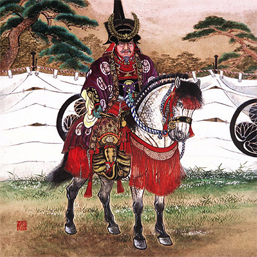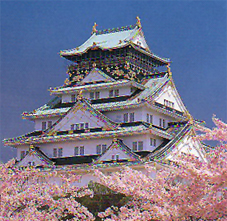Tokugawa
From the Quicksilver Metaweb.
This is a page for Tokugawa Ieyasu and the Tokugawa Shogunate
Stephensonia
Daniel Waterhouse had the Kamakura bakufu as one topic amongst his Logic Mill cards.
Authored entries
- Stephenson:Neal:Quicksilver:36:According to what scheme? (Alan Sinder)
- Stephenson:Neal:Quicksilver:299: When you turn the crank?(Alan Sinder)
Tokugawa Ieyasu
Tokugawa Ieyasu (徳川 家康 January 30, 1543 - June 1, 1616) was the most powerful man in Japan after Hideyoshi had died in 1598. Against his promises he did not respect Hideyoshi's successor Hideyori because he wanted to become the absolute ruler of Japan.
Tokugawa Ieyasu
The Napoleon of Japan
In the Battle of Sekigahara in 1600, Ieyasu defeated the Hideyori loyalists and other Western rivals. Hence, he achieved almost unlimited power and wealth. In 1603, Ieyasu was appointed Shogun by the emperor and established his government in Edo (Tokyo). The Tokugawa shoguns continued to rule Japan for over remarkable 250 years.
Tokugawa Shogunate
The Tokugawa shogunate or Tokugawa bakufu (徳川幕府) (also known as the Edo bakufu) was a feudal military dictatorship of Japan established in 1603 by Tokugawa Ieyasu and ruled by the shoguns of the Tokugawa family until 1868. This period is known as the Edo period and gets its name from the capital city of Edo, now Tokyo.
Following the Sengoku Period of "warring states", central government had been largely re-established by Oda Nobunaga and Toyotomi Hideyoshi during the Azuchi-Momoyama period. After the Battle of Sekigahara in 1600, central authority fell to Tokugawa Ieyasu who completed this process and received the title of shogun in 1603. His descendants were to hold the position, and the central authority that came with it, until the 19th century.
The Tokugawa period, unlike the shogunates before it, was based on the strict class hierarchy originally established by Toyotomi Hideyoshi. The warrior-caste of samurai were at the top, followed by farmers, artisans, and traders. Ironically, the very strictness of the caste system was to undermine these classes in the long run. Taxes on the peasantry were set to fixed amounts which did not account for inflation or other changes in monetary value. As a result, the tax revenues collected by the samurai landowners were worth less and less over time. This often led to confrontations between noble but impoverished samurai and well-to-do peasants.
Zen
Originally formulated by the eponymous Chinese master Linji (Rinzai in Japanese), the Rinzai school was introduced to Japan in 1191 by Eisai, whose disciple Dogen went on to found the Soto Zen school. Obaku was introduced in the 17th century by a Ingen, a Chinese monk.
Influenced by Taoism, Zen de-emphasizes study and worldly deeds, and concentrates instead on meditation and a non-rational awareness of the world and the way the mind reacts to it. The following Zen traditions still exist in Japan: Rinzai, Soto, and Obaku.
The Restoration of the Meiji
Toward the end of the 19th century, an alliance of several of the more powerful daimyo with the titular Emperor finally succeeded in the overthrow of the shogunate after the Boshin War, culminating in the Meiji Restoration. The Tokugawa bakufu came to an official end in 1868 with the resignation of the 15th Tokugawa Shogun Tokugawa Yoshinobu and the "restoration" ('Taisei Houkan') of imperial rule.
The Tokugawa Legacy
Ieyasu brought the whole country under tight control. He cleverly redistributed the gained land among the daimyo: more loyal vassals (the ones who supported him already before Sekigahara) received strategically more important domains accordingly. Every daimyo was also required to spend every second year in Edo. This meant a huge financial burden for the daimyo and moderated his power at home.
Ieyasu continued to promote foreign trade. He established relations with the English and the Dutch. On the other hand, he enforced the suppression and persecution of Christianity from 1614 on.
After the destruction of the Toyotomi clan in 1615 when Ieyasu captured Osaka Castle (大坂城 Ôsakajô), he and his successors had practically no rivals anymore, and peace prevailed throughout the Edo period. Therefore, the warriors (samurai) were educating themselves not only in the martial arts but also in literature, philosophy and the arts, e.g. the tea ceremony.
Osaka Castle
In 1633, shogun Iemitsu forbade travelling abroad and almost completely isolated Japan in 1639 by reducing the contacts to the outside world to very limited trade relations with China and the Netherlands in the port of Nagasaki. In addition, all foreign books were banned.
Despite the isolation, domestic trade and agricultural production continued to improve. During the Edo period and especially during the Genroku era (1688 - 1703), popular culture flourished. New art forms like kabuki and ukiyo-e became very popular especially among the townspeople.
Class Structure
The most important philosophy of Tokugawa Japan was Neo-Confucianism, stressing the importance of morals, education and hierarchical order in the government and society: A strict four class system existed during the Edo period: at the top of the social hierarchy stood the samurai, followed by the peasants, artisans and merchants. The members of the four classes were not allowed to change their social status.
Outcasts Eta (literally, "full of filth") or hisabetsu buraku (被差別部落), people with professions that were considered impure, formed a fifth class. Today the Eta are known as the Burakumin (部落民, buraku community + min people), and are still shunned along with other minorities like Japanese born Koreans and Chinese. The myth is they are the labor of the criminal class. They are descendants of premodern outcast hereditary occupational groups, such as butchers, leatherworkers, and certain entertainers. Discrimination against these occupational groups arose historically because of Buddhist prohibitions against killing and Shinto notions of "Kegare", as well as governmental attempts at social control. They occupied the lowest level of the social hierarchy of Feudal Japan. However, because they had an unconditional monopoly in these fields, some succeeded economically and obtained Samurai status through marrying or outright buyout of troubled houses.
In 1720, the ban of Western literature was cancelled, and several new teachings entered Japan from China and Europe (Dutch Learning). New nationalist schools that combined Shinto and Confucianist elements also developed.
Even though the Tokugawa government remained quite stable over several centuries, its position was steadily declining for several reasons: A steady worsening of the financial situation of the government led to higher taxes and riots among the farm population. In addition, Japan regularly experienced natural disasters and years of famine that caused riots and further financial problems for the central government and the daimyo. The social hierarchy began to break down as the merchant class grew increasingly powerful while some samurai became financially dependent of them. In the second half of the era, corruption, incompetence and a decline of morals within the government caused further problems.
The Opening of Japan
In the end of the 18th century, external pressure started to be an increasingly important issue, when the Russians first tried to establish trade contacts with Japan without success. They were followed by other European nations and the Americans in the 19th century. It was eventually Commodore Perry in 1853 and again in 1854 who forced the Tokugawa government to open a limited number of ports for international trade. However, the trade remained very limited until the Meiji restoration in 1868.
All factors combined, the anti-government feelings were growing and caused other movements such as the demand for the restoration of imperial power and anti western feelings, especially among ultra-conservative samurai in increasingly independently acting domains such as Choshu and Satsuma. Many people, however, soon recognized the big advantages of the Western nations in science and military, and favoured a complete opening to the world. Finally, also the conservatives recognized this fact after being confronted with Western warships in several incidents.
In 1867-68, the Tokugawa government fell because of heavy political pressure, and the power of Emperor Meiji was restored.
Nikko-Ji
Tokugawa was enshrined in Nikko (日光市; -shi) after his death. The city located in the mountains of Tochigi prefecture, Japan. It is a popular destination for Japanese tourists, housing his mausoleum (Nikko Toshogu), as well as the Futarasan Jinja shrine which dates to the year 767. There are also many famous hot springs (onsen) in the area. The mountains west of the city are part of Nikko National Park and contain some of the country's most spectacular waterfalls and scenic trails. Sargent (1894; The Forest Flora of Japan) recorded that a Daimyo who was too poor to offer a stone lantern at the funeral, requested instead to be allowed to plant an avenue of Sugi - a large Japanese evergreen, 'that future visitors might be protected from the heat of the sun'. The offer was accepted; the avenue, which still exists, is over 65km (40 miles) long, and 'has not its equal in stately grandeur'. As of 2003, the city has an estimated population of 16,751 and a density of 52.19 persons per km². The total area is 320.98 km². The city was founded on February 1, 1954.



References
- ISBN 0674390261 Mary Elizabeth Berry, Hideyoshi (Harvard East Asian Monographs, No 146 Publisher: Harvard 1982; Reprint edition (July 1989)
- ISBN 1841761168 Anthony Bryant, Sekigahara 1600; Publisher: Osprey Pub Co; (November 2000)
- ISBN 0804715114 John W. Hall and Marius Jansen (ed.) Studies in the Institutional History of Early Modern Japan; Publisher: Princeton 1968
- ISBN 0521484049 Marius Jansen (ed.) Warrior Rule in Japan; Publisher: Cambridge University Press; (September 29, 1995)
- ISBN 0893462101 Conrad Totman, Tokugawa Ieyasu: Shôgun Publisher: Heian Intl Pub Co; (May 1988)